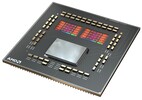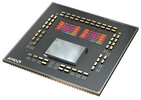Intel Core i5-12600H vs AMD Ryzen 7 5700X vs AMD Ryzen 7 5800X
Intel Core i5-12600H
► remove from comparison
The Intel Core i5-12600H is a high-end mobile CPU for laptops based on the Alder Lake architecture. It was announced in early 2022 and offers 4 of the 6 performance cores (P-cores, Golden Cove architecture) and all 8 efficient cores (E-cores, Gracemont architecture). The P-cores support Hyper-Threading leading to 16 supported threads when combined with the E-cores. The clock rate ranges from 2.7 to 4.5 GHz on the performance cluster and 2 to 3.3 GHz on the efficient cluster. The performance of the E-cores should be similar to old Skylake cores (compare to the Core i7-6700HQ). All cores can use up to 18 MB L3 cache. Compared to the 12650H, the 12600H offers less P-cores but more E-cores, a faster iGPU and "Enterprise" vPro features (for remote management).
Performance
Thanks to the 12 cores, the multi-threaded performance should be clearly faster than the older Tiger Lake-H CPUs with similar clock speeds (especially like the Core i5-11500H with only 6 cores). Due to the architectural improvements, single-core performance is also better than similar or higher clocked Tiger Lake CPUs.
Features
The integrated memory controller supports various memory types up to DDR5-4800, DDR4-3200, LPDDR5-5200, and LPDDR4x-4267. The Thread Director (in hardware) can support the operating system to decide which thread to use on the performance or efficient cores for the best performance. For AI tasks, the CPU also integrates GNA 3.0 and DL Boost (via AVX2). Quick Sync in version 8 is the same as in the Rocket Lake CPUs and supports MPEG-2, AVC, VC-1 decode, JPEG, VP8 decode, VP9, HEVC, and AV1 decode in hardware. The CPU only supports PCIe 4.0 (x8 for a GPU and two x4 for SSDs).
The integrated graphics card is based on the Xe-architecture and offers 80 of the 96 EUs (Execution Units) operating at up to 1.4 GHz.
The CPU is rated at 45 W base power (95 W PL2) but most laptops will use a PL1 of around 60 Watt. The SoC is manufactured in a 10nm process at Intel, which is known as Intel 7.
AMD Ryzen 7 5700X
► remove from comparison
The AMD Ryzen 7 5700X is a desktop processor with 8 cores and simultaneous multithreading (SMT), which means it can process 16 threads simultaneously. In April 2022, AMD presented the Ryzen 7 5700X, a new 8-core processor that is very similar to the AMD Ryzen 7 5800X. However, due to the lower TDP, there are no restrictions on the clock frequency. Nevertheless, the AMD Ryzen 7 5700X reaches up to 4.6 GHz in boost, which is only 100 MHz less than the AMD Ryzen 7 5800X. However, the base clock drops significantly to 3.4 GHz.
The performance of the AMD Ryzen 7 5700X is consistently excellent in all applications. The native 8-core can really show off its strengths, especially in multi-threaded applications, although the single-core performance has also been significantly improved compared to the older Zen 2 architecture.
The internal structure of the processor is similar to the AMD Ryzen 7 5800X. The CCX modules are also connected to each other via the I/O die, which we already know from Zen2. However, according to AMD, the Infinity Fabric should now achieve clock rates of up to 2 GHz, which in turn enables a RAM clock rate of 4,000 MHz without any loss of performance.
In terms of manufacturing processes, AMD also relies on TSCM for the 7nm production of the CPU cores in the Vermeer processors, although the I/O die is still supplied in 12 nm by Globalfoundries.
The AMD Ryzen 7 5700X is impressive in gaming thanks to the significantly improved IPC compared to Zen2. In terms of power consumption, the AMD Ryzen 7 5700X impresses with its low TDP of just 65 watts. This means that the processor can also be operated with a compact air cooler without any problems. The AMD Ryzen 7 5800X is operated with a TDP of 105 watts.
AMD Ryzen 7 5800X
► remove from comparison
The AMD Ryzen 7 5800X is an 8-core desktop processor with Simultaneous Multithreading (SMT), which allows it to process 16 threads simultaneously. With its launch on 08.10.2020, it is the fastest 8-core processor from AMD. The second fastest 8-core processor will be the AMD Ryzen 7 3800XT, followed by the more economical AMD Ryzen 7 3700X, also with 8 cores and 16 threads.
The Ryzen 7 5800X clocks with a base clock of 3.8 GHz and reaches up to 4.7 GHz on one core in turbo mode. When all 8 cores are utilized, the AMD Ryzen 7 5800X, like the AMD Ryzen 9 5900X, achieves up to 4.5 GHz.
At first glance, the internal structure of the processor has not changed fundamentally. The CCX structure has changed somewhat compared to Zen2, because now a CCX consists of up to 8-CPU cores. So each individual core can access the complete L3 cache (32 MByte). Furthermore the CCX modules are connected to each other via the same I/O die, which we already know from Zen2. According to AMD, the Infinity-Fabric should now reach clock rates of up to 2Ghz, which in turn allows a RAM clock of 4.000 MHz without performance loss.
Performance
The average 5800X in our database is in the same league as the Core i9-10900K and also the Core i7-12700F, as far as multi-thread benchmark scores are concerned.
In games, AMD's Ryzen 7 5800X can convince with its significantly improved IPC and even put Intel in its place. With the AMD Ryzen 7 5800X, gamers are well prepared for the future as simultaneous streaming is no problem with the new Ryzen 7 5800X. Semi-professional content creators, who need even more power, can choose a Ryzen 9 5900X or the Ryzen 9 5950X on the shelf.
Power consumption
The Ryzen 7 has a default TDP (also known as the long-term power limit) of 105 W. This applies as long as the CPU runs at stock clock speeds.
Ryzen 7 5800X is built with TSMC's 7 nm process; as rumors have it, the I/O die is manufactured separately on the 12 nm Global Foundries process.
| Model | Intel Core i5-12600H | AMD Ryzen 7 5700X | AMD Ryzen 7 5800X | ||||||||||||||||||||||||||||||||||||||||||||||||||||||||||||
| Codename | Alder Lake-H | Vermeer (Zen 3) | Vermeer (Zen 3) | ||||||||||||||||||||||||||||||||||||||||||||||||||||||||||||
| Series | Intel Alder Lake-P | AMD Vermeer (Ryzen 5000) | AMD Vermeer (Ryzen 5000) | ||||||||||||||||||||||||||||||||||||||||||||||||||||||||||||
| Series: Vermeer (Ryzen 5000) Vermeer (Zen 3) |
|
|
| ||||||||||||||||||||||||||||||||||||||||||||||||||||||||||||
| Clock | 2000 - 4500 MHz | 3400 - 4600 MHz | 3800 - 4700 MHz | ||||||||||||||||||||||||||||||||||||||||||||||||||||||||||||
| L1 Cache | 1.1 MB | 512 KB | 512 KB | ||||||||||||||||||||||||||||||||||||||||||||||||||||||||||||
| L2 Cache | 10 MB | 4 MB | 4 MB | ||||||||||||||||||||||||||||||||||||||||||||||||||||||||||||
| L3 Cache | 18 MB | 32 MB | 32 MB | ||||||||||||||||||||||||||||||||||||||||||||||||||||||||||||
| Cores / Threads | 12 / 16 | 8 / 16 | 8 / 16 | ||||||||||||||||||||||||||||||||||||||||||||||||||||||||||||
| TDP | 45 Watt | 65 Watt | 105 Watt | ||||||||||||||||||||||||||||||||||||||||||||||||||||||||||||
| Technology | 10 nm | 7 nm | 7 nm | ||||||||||||||||||||||||||||||||||||||||||||||||||||||||||||
| max. Temp. | 100 °C | 90 °C | 90 °C | ||||||||||||||||||||||||||||||||||||||||||||||||||||||||||||
| Socket | BGA1744 | 1331 | AM4 (LGA1331) | ||||||||||||||||||||||||||||||||||||||||||||||||||||||||||||
| Features | DDR4-3200/LPDDR4x-4266/DDR5-4800/LPDDR5-5200 RAM, PCIe 4, Thr. Dir., DL B,., GNA, vPro En., RPE, MMX, SSE, SSE2, SSE3, SSSE3, SSE4.1, SSE4.2, AVX, AVX2, BMI2, ABM, FMA, ADX, VMX, SMX, SMEP, SMAP, EIST, TM1, TM2, HT, Turbo, SST, AES-NI, RDRAND, RDSEED, SHA | MMX(+), SSE, SSE2, SSE3, SSSE3, SSE4.1, SSE4.2, SSE4A, x86-64, AMD-V, AES, AVX, AVX2, FMA3, SHA, Precision Boost 2 | DDR4-3200 RAM, PCIe 4, MMX (+), SSE, SSE2, SSE3, SSSE3, SSE4.1, SSE4.2, SSE4A, AES, AVX, AVX2, FMA3, SHA | ||||||||||||||||||||||||||||||||||||||||||||||||||||||||||||
| iGPU | Intel Iris Xe Graphics G7 80EUs ( - 1400 MHz) | ||||||||||||||||||||||||||||||||||||||||||||||||||||||||||||||
| Architecture | x86 | x86 | x86 | ||||||||||||||||||||||||||||||||||||||||||||||||||||||||||||
| Announced | |||||||||||||||||||||||||||||||||||||||||||||||||||||||||||||||
| Manufacturer | ark.intel.com | www.amd.com | www.amd.com | ||||||||||||||||||||||||||||||||||||||||||||||||||||||||||||
| Die Size | 2 x 74 sq. mm; I/O = 125 sq. mm mm2 | 2 x 80.7 sq. mm; I/O = 125 mm2 | |||||||||||||||||||||||||||||||||||||||||||||||||||||||||||||
| $299 U.S. | $449 U.S. |
Benchmarks
Average Benchmarks AMD Ryzen 7 5700X → 0% n=0
Average Benchmarks AMD Ryzen 7 5800X → 0% n=0
* Smaller numbers mean a higher performance
1 This benchmark is not used for the average calculation












